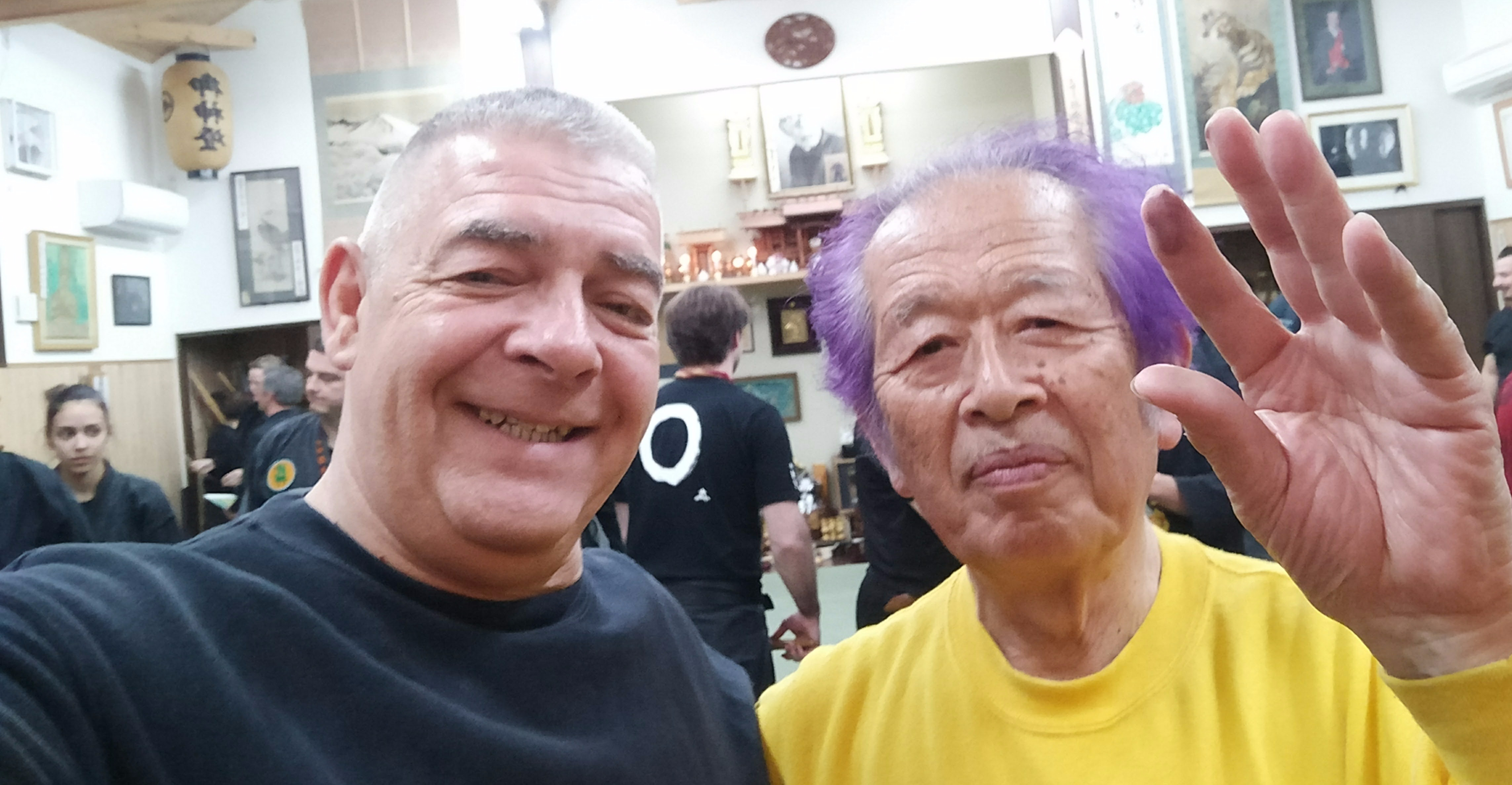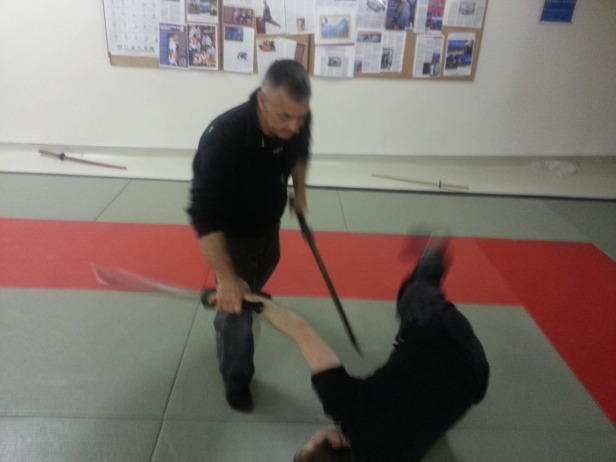Read Between The Lines
From Shiro Kuma by kumablog
 強弱柔剛あるベからず
強弱柔剛あるベからずFrom Shiro Kuma by kumablog
 強弱柔剛あるベからず
強弱柔剛あるベからずFrom Shiro Kuma by kumablog
 強弱柔剛あるベからず
強弱柔剛あるベからずFrom Shiro Kuma's Blog by kumablog
 This year Mutō dori is about controlling Funiki, your environment.
This year Mutō dori is about controlling Funiki, your environment.
During the class, Hatsumi sensei demonstrated it with Taijutsu, Tantō, Katana, and Naginata. Each time the Uke seemed lost and unable to get him. His main point today was that the weapon, or the lack of it, is not what truly matter. In fact, with or without a weapon, Sensei was moving very slowly, keeping a perfect distance with the opponent, who always ended up cutting, stabbing himself, or getting controlled. There was no fight, no opposition, Sensei’s movements were natural. From the outside, it looked like Uke was fighting alone.
Sensei demonstrated it with the Tantō, using a unique grip that let his Taijutsu play by itself.
You hold the knife reverse, hiding it under your forearm and use either the blade or the Kashira to get Uke naturally. (2)
The key, he said, is not to use the Tantō, and to let Uke cut himself in the process. Correcting a student he told her that thinking about cutting with the blade, created a Teko (3), a point of leverage and focus that the opponent can use against you. Sensei added that in the case of a small weapon, it had to be always hidden.
But when Uke finally sees it, the trick is to let Uke “think” the knife while Tori still ignores it and his mind is not trapped by it. Sensei added that when you want to cut or stab with your knife, you are creating a fixed point in your mind limiting your freedom of action.
With the Naginata; it was even more devastating. Sensei said that when using this weapon, your grip of the weapon should be loose and all the movements executed using Naname. (4)
My understanding is that the physical encounter is enough to cut the enemy, your body supporting the Naginata loosely on top of the forearm. Also, keeping the edge oriented at 45 degrees guarantees a cut when in close-combat. The cuts are done by walking the body around Uke. When he was demonstrating this, I had the feeling the Naginata was alive and moving by itself.
In a sword against sword encounter, he explained to move towards the attack, using the body to support the blade as a shield. With the weapons in contact use the joints to apply leverage. Grab the opponent’s sword and then slide your katana under his helmet.
Finally, in Taijutsu, Sensei reminded us to use our fingers as if playing the piano on Uke. Then one finger extended was often enough to overcome the adversary even when he was armed with a sword.
All these techniques that we did were practical applications of high-level Mutō Dori. Mutō Dori is entirely misunderstood. It is not what we learned at beginner’s level. Mutō Dori is done in every situation, with or without weapons. Because it is about controlling Fun’iki (1), the environment, the atmosphere.
When your mental presence is aware of everything and controls the space between and around you and the opponent, then defeat is never yours. (5) (6)
The essence of Mutō Dori is Fun’Iki, to control the environment naturally.
________________________
1. 雰囲気, Fun’iki or Fuinki, air, atmosphere, environment
2. Kashira 頭, the head/top of the weapon/hilt
3. 梃子, lever(age). Teko – lever, and Shiten – fulcrum are one the secrets of the Kukishin Ryū
4. Naname 斜め, diagonal, oblique
5. Sensei used the word Fudōshin (不動心) to express it. And many of his attackers today explained that they cannot get him because of his commanding presence.
6. 不動心, Fudōshin: a) imperturbability; steadfastness
b) cool head in an emergency; keeping one’s calm (e.g. during a fight)
From Shiro Kuma's Blog by kumablog

The last class with Hatsumi Sensei was so intense that I dreamt of it all night long. In my dreams, what he showed and taught made more sense, I will do my best to explain now what I got out of it.
To control the space with mutō dori, you have to be zero.
To be zero, you have to be one.
To be one, you have to be complete.
To be complete, you have to be sanshin (3).
To be sanshin, you have to know your basics.
To know your basics, you have to enter the dōjō.
When we begin our training, we are formless. We have expectations and no knowledge. The teacher shows the basics, and with practice, we are starting to move in the appropriate form. Then we have to acquire the basics of the Tenchijin.
When we begin to understand the simple complexity of the Tenchijin we are three. This is the sanshin of the Ten, the Chi, and the Jin. There is no unity yet in our movements, and our taijutsu looks like robotic movements. With time, the differentiation of the three parts of the Tenchijin vanishes, and we start having a more unified way of moving.
When this process is complete, we can enter the world if the Ryûha and to study the weapons. After some time, we mix the Waza, the Buki, the basics, and a nice body flow emerges. We are complete.
But the hard work doesn’t stop here, as it is only the beginning. Give it a little more time, and you become “one”. Only when this state of “being one” is achieved, that you can start the long path of becoming “zero”.
It is a long process because you have to get rid of everything you have learned to be “zero”. Sensei said that “there are no techniques”. What I understood is that at this level, techniques are useless, you have to forget them. And you can do that only because you spent at least twenty years learning them (1). Again, you can only forget something you have learned.
Gradually, you can become zero and ride on uke’s intentions. Because you have no expectations, because you do not try to win, you are in control of the space. Uke’s attacks originate from the same point in space that you can now clearly see. Controlling this point defeats uke. Sensei said that whether attacks using taijutsu or weapons, there is a common point, and it is always the same. As you fill the space of battle, you can see this point. Control it, and things are easy. Sensei insisted twice on the importance of Kokyû, respiration. (2) He said that if you are out of breath at the end of the exchange, it is because you are still trying to do something. But you don’t have it.
When you are finally capable to ride uke’s attacks, to dodge them, and still be relaxed, it is the proof that you are zero.
Once again here is the path to follow:
Learn and study the basics,
Learn and study the Tenchijin,
Become three.
Learn and study the Ryûha and the weapons,
Become One.
Unlearn and forget everything,
Be Zero and control the space.
“Zero is not empty. There’s a point in the middle”, Hatsumi sensei, July 2016.
________________
1. I write “twenty years” here, but it might be thirty. In just beginning to grab it after more than thirty years in the Bujinkan. But I guess some are more gifted than me. On the other hand, if you have been training less than twenty years, and have achieved a high rank in the Bujinkan, I am confident that this will require some more years of training. Rank doesn’t mean competence.
2. 呼吸/Kokyû /breath; respiration|knack; trick; secret (of doing something)
Visit our new portal KUMA HUB
From Shiro Kuma's Blog by kumablog

When I arrived in Kashiwa yesterday, I met my friend Philippe from France, and his students for dinner.